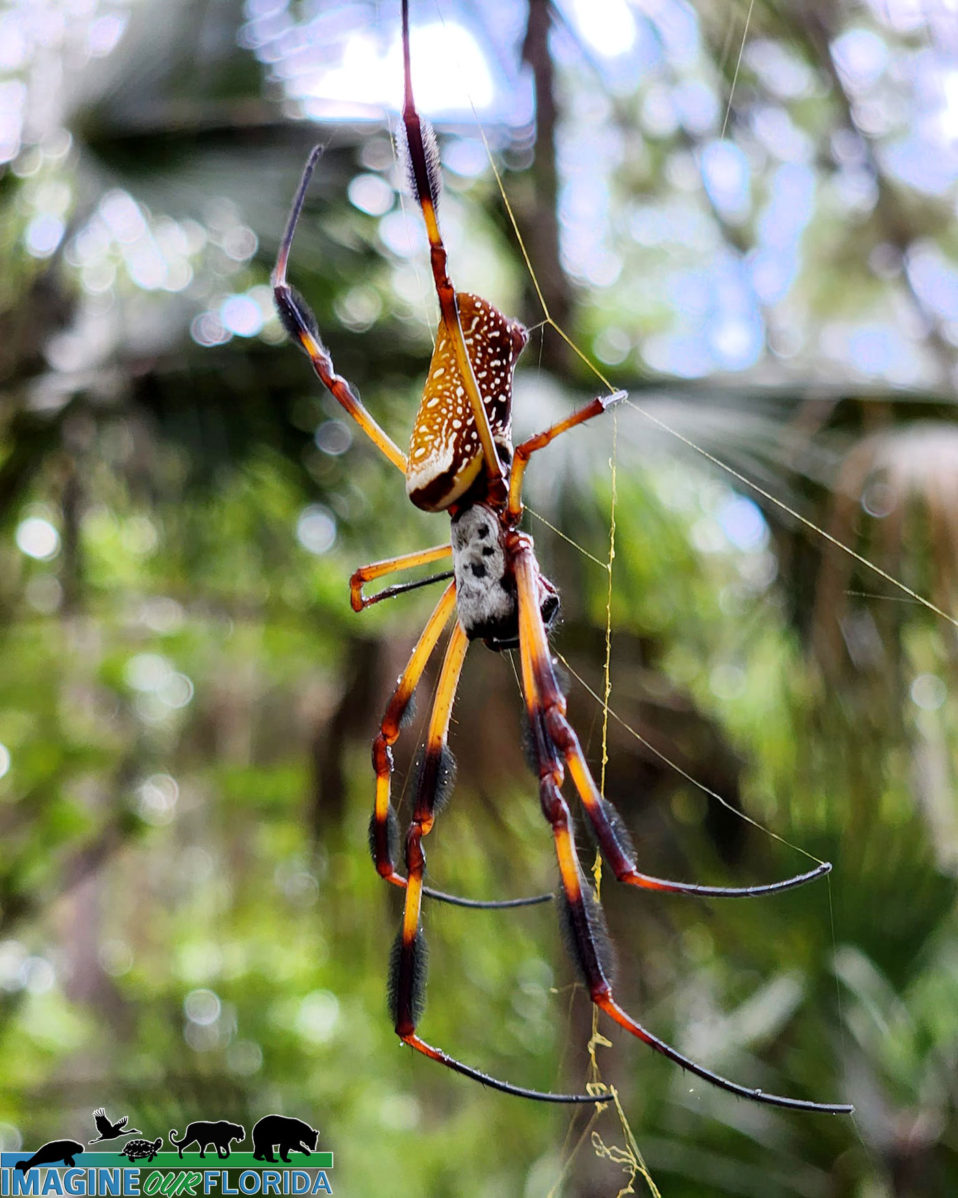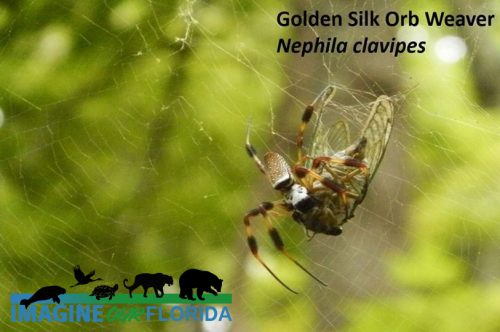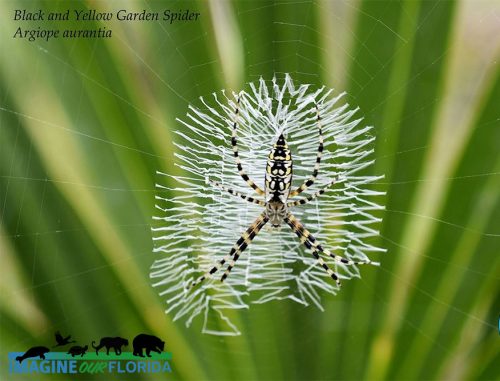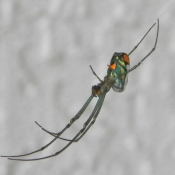Green Lynx Spider
Banana Spider
Red-femured Spotted Orbweaver Spider
Banded Garden Spider
Northern Crab Spider
Silver Garden Orbweaver
Dewdrop Spider
Tiny Dewdrop Spiders (Argyrodes sp.) are easy to miss. Nature has designed their abdomens to reflect light and appear to be a dewdrop glimmering in the sun.
Dewdrop spiders do not spin their own webs. Instead, they perch on the outer edge of a larger spider’s web. Once an insect is captured in the web, the tiny Dewdrop Spider will wait patiently until the host spider leaves the web before moving in to steal a bit of the prey.
Dewdrop spiders are aptly known as kleptoparasites.
Photo Credit: Andy Waldo
Regal Jumping Spider
Regal Jumping Spiders (Phidippus regius) are cute little fuzzy spiders typically found around immature woodland habitats. They can also be found hanging out on your windshield. Black and white features identify males. Females are grey or brown in color. These spiders may be expert jumpers, but they also produce a dragline in case they miss their target.
Males perform a romantic dance to woo the females. They show off their handsome leg fringe and bright metallic green chelicerae. If the lady is impressed, they will cohabitate in dried leaves such as old palm fronds. When the mating time arrives, the male does another type of romantic dance that is different from his courtship dance. During this dance, he shows off his dance moves and then plays a game of peek-a-boo with the female through the tent-like web. Once the female allows him in, he softly pets her several times before mating occurs. Quite the charmer, isn’t he?
When it comes time to lay eggs, the female will produce several nests under pine and oak trees. Several hundred eggs can be laid during this time. Babies will consume small invertebrates. While they may strike fear into other insects, they are relatively harmless to humans. Rough handling of the spiders may prompt a bite that can sting for several minutes before subsiding.


Giant Whip Scorpion
The Giant Whip Scorpion (Vinegaroon, Mastigoproctus giganteus) is the only whip scorpion with a tail found in the United States. Whip refers to its long thin tail. Vinegaroon is derived from the vinegar scent created by a spray of concentrated (85%) acetic acid that emanates from the base of the tail.
The Vinegaroon, an arachnid, can grow to 2 inches long. It does not have a stinger filled with venom like other scorpions. They have eight rather weak eyes. Nature has provided them with long, thin front legs to use as antennae to feel their food and a tail, which serves as a sensory organ. They make their homes underground in well-drained soil. You will see them most often when they come to the surface during the rainy season.
After a 12-hour mating ritual in autumn, the female will carry the eggs internally for several months before laying 30 to 40 eggs into an egg sac. She will remain in her burrow for 2 months while holding the egg sac off the ground. Once hatched, the white-colored babies and will ride on their mother’s back for about 30 days. After their first molt, the babies look like adults and will leave their mother. Before becoming adults, the new Vinegaroons will molt three more times at intervals of about one year. Life expectancy is 7-8 years.
Giant Whip Scorpions dine on Florida woods roaches, termites, and crickets. They catch their prey with their large pincers and kill them by crushing them with their teeth. Vinegaroons make tasty treats for raccoons, armadillos, skunks, feral hogs, and black bears.
If threatened, the Giant Whip Scorpion will either hide in its burrow or rear up and spread its legs. They may spray a vinegar scented acid, which will accurately hit their enemy up to a foot away. The spray packs a mighty sting to the predator’s nostrils and eyes. If handles, they pack a powerful pinch.
Red Widow Spider
Red Widow Spiders (Latrodectus bishopi), although endemic to Florida, live in a limited range. Red Widow Spiders can be found in Lake Wales Ridge and other Central and Southern Florida areas. The Spider lives in sand pine scrub habitats and makes its homes in palmettos and other shrubs. Red Widow Spiders are listed as a Threatened Species due to the destruction of habit.
A Red Widow will bind together palmetto leaves with silk to mate, hide, and guard her eggs. The egg sac, which is smooth and white, is deposited inside the silk-lined rolled frond. She binds the tips of the palmetto fronds, and her web becomes invisible during the day. The web can only be seen on foggy mornings.
The web looks like a cobweb sheet with snare lines. An insect will fly into the snares and fall to the sheet. The Spider will rush out to retrieve her prey. She will eat insects of all kinds caught in the web but primarily feasts on beetles endemic to the area in the spring. Bees and wasps are favorites during the rest of the year. Although the male is capable of hunting his own prey, he will most often eat the prey provided by the female.
The Red Widow’s abdomen is black with red dots bordered with yellow. Its head, legs, and thorax are red-orange. The female is 1/2 an inch with a leg span of 1/2 to 2 inches. The male is 1/3 to 1/2 the size of the female.
Although the female’s venom is a neurotoxin that causes sustained muscle spasms, very few bites and no deaths have been attributed to the Red Widow Spider. These spiders are rarely encountered and only bite when touched. Wear gloves when lifting firewood or picking up wood and other items in areas where spiders may be living. Red Widows have been known to make their homes in sheds and garages. If a Red Widow Spider bites you, seek medical attention.
Photo Credit: freshfromflorida.com/es/
Golden Silk Orb Weaver
The Golden Silk Orb-Weaver (Trichonephila clavipes) is dreaded by hikers and bikers in the forest. Their sticky, golden webs, which can measure 6 1/2 feet in diameter, are spun in insect flight paths in open woods and at the edge of dense forests. You may run into them in your yard, where they are spun between trees and dense shrubs. The large webs catch flies, bees, wasps, moths, butterflies, male orb-weavers, and more. The prey is devoured by the spider, who is waiting patiently on the web.
Golden Silk Orb-Weavers are also known as Banana Spiders because of their yellow coloring. Their color variation, complete with furry-looking tufts on their legs, helps them blend into the forest. They are also known as Giant Wood Spiders because the females’ bodies are more than 1 1/2 inches and, including legs, can measure up to 5 inches in diameter. Males are significantly smaller, with bodies at about 1/4 of an inch.
The small males come out to mate between July and September. The females produce at least two egg sacs per year but have been known to produce up to nine. Each sac contains a few hundred eggs. The female often eats the male after mating.
Climate change has mildly affected these spiders’ behavior. Still, they have adapted by creating reflective carapaces and turning the cylindrical parts of their bodies towards the sun to reduce the heated body surface. They also reduce heat by holding a drop of water in their chelicerae (mouth-part) and allowing it to evaporate. This has allowed them to adapt very well to their environment.
The next time these little ones give you a scare, take a few minutes to appreciate their hard work. Golden Silk Orb-Weavers play an important role in our ecosystems. Orange and pecan farmers appreciate their cooperation in keeping pests away from harvests. These fascinating spiders provide insect control in our wild spaces and our yards.
Black and Yellow Garden Spider
Here’s a little girl that many people will be quick to recognize. She’s a young black and yellow garden spider. These spiders range all across the United States and up into Canada as well as south into Mexico and Central America. The spiderlings emerge in spring from egg sacs laid the prior year.
The dense zigzag of silk in the middle of the web is known as the stabilimentum. The true purpose of this structure is in dispute. Some say it is to provide camouflage to the spider resting in the center. Others think it acts as an attractant to insect prey or a deterrent to birds who could fly into the nest and damage it. Every night, the female eats the center of her web and then rebuilds it in the morning.
Their bites are comparable to a bee sting and are harmless to healthy adults and those who are not allergic to their venom. They maintain a clean and orderly web and help remove loads of insects. They are great to have around and are a truly beautiful arachnid. We hope everyone gets a chance to get out this weekend and enjoy the outdoors!
Black-Tailed Red Sheet Weaver
The black-tailed red sheet weaver (Florinda coccinea.) These spiders get their name from the black cerebellum or tail and the webs they weave, which resemble a sheer material. They have two different parts of their web. The top part is intended to knock flying insects down, and the bottom sheet catches them in a non-sticky web where the spider attacks the prey. They can be instrumental in controlling flying bugs in your yard and are even encouraged as a pest control method in agriculture. They were historically popular among Florida orange groves.
The spiders can be found upside down in their webs. Typically, males are either the same size or smaller than the female. Smaller males can sometimes be seen on the same web as larger females. Both take part in creating the web and cleaning it. Talk about the perfect couple.
Mating can get a bit complex, though. The courtship ritual of these spiders consists of 18 different behaviors ranging from reduction of the web to the act of copulation. Spider sex can be a bit weird. The females first release their sex hormones onto the net. The male finds the female and reduces the web to prevent other males from reaching her. If the female approves of the male, she positions herself. If the male tries to mate without permission, there is a good chance the female may eat him. Mating is not done like most animals. The male deposits his sperm packets onto the web and then uses his pedipalps to place the packets into the female’s sex organs. They are stored near the ovaries until the female decides to lay eggs.
Next time someone tells you science is boring, tell them about the black-tailed red sheet weaver, and maybe they will start watching more nature and less TV!
Mabel Orchard Orb Weaver
The Mabel Orchard Orb Weaver (Leucauge mabela) is common throughout Florida. It is one of the prime examples of evolutionary adaption, being that it has adapted to a wide range of habitats and climates. It can be found as far north as Canada and as far south as Columbia. Reproduction is similar to most spiders, where sperm packets are transferred, but the females can be very particular about their mates. If specific behaviors are not followed, it could mean the male gets eaten.
These spiders are efficient at pest control and have been historically welcomed in agriculture to reduce pests that would otherwise destroy crops. They are also very effective against mosquitoes. However, they become prey to many bird species. They are also hosts for wasp larvae. Wasps may paralyze the spiders and lay their eggs on them. As the wasp larvae grow, they feed off the body of these spiders.
Perhaps one of the most notable facts about this spider is that it is the only spider family to receive its nomenclature from Charles Darwin. Darwin first discovered a spider in Brazil during his voyage on the H.M.S. Beagle. It didn’t fit into any previously noted genus, so he classified it under Leucauge. This has become one of the larges groups of spiders currently documented. This is greatly due to its ability to adapt successfully to a changing environment through natural selection. This has lead to various species of these spiders. The one discovered by Darwin was named Leucauge argyrobapta. This species, Leucauge mabela likely selected for traits that helped it adapt to a different environment.































Recent Comments